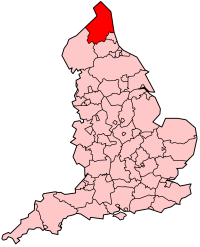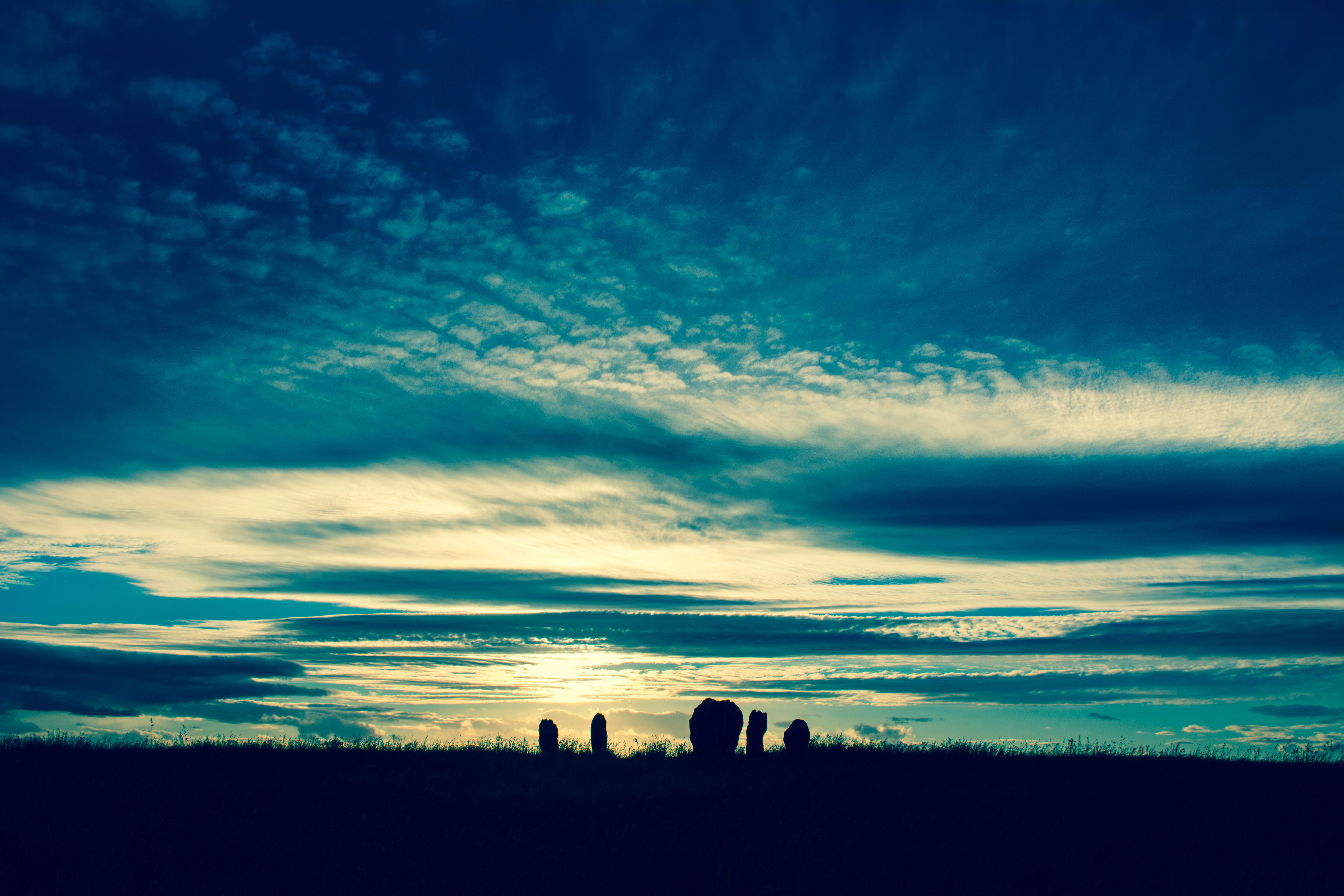|
History Of Northumberland
Northumberland, England's northernmost county, is a land where Roman occupiers once guarded a walled frontier, Anglian invaders fought with Celtic natives, and Norman lords built castles to suppress rebellion and defend a contested border with Scotland. The present-day county is a vestige of an independent kingdom that once stretched from Edinburgh to the Humber, hence its name, meaning literally 'north of the Humber'. Reflecting its tumultuous past, Northumberland has more castles than any other county in England, and the greatest number of recognised battle sites. Once an economically important region that supplied much of the coal that powered the industrial revolution, Northumberland is now a primarily rural county with a small and gradually shrinking population. Prehistory As attested by many instances of rock art, the Northumberland region has a rich prehistory. Archeologists have studied a Mesolithic structure at Howick, which dates to 7500 BC and was identified as Br ... [...More Info...] [...Related Items...] OR: [Wikipedia] [Google] [Baidu] |
Britons (historical)
The Britons ( *''Pritanī'', la, Britanni), also known as Celtic Britons or Ancient Britons, were people of Celtic language and culture who inhabited Great Britain from at least the British Iron Age and into the Middle Ages, at which point they diverged into the Welsh, Cornish and Bretons (among others). They spoke the Common Brittonic language, the ancestor of the modern Brittonic languages. The earliest written evidence for the Britons is from Greco-Roman writers and dates to the Iron Age.Koch, pp. 291–292. Celtic Britain was made up of many tribes and kingdoms, associated with various hillforts. The Britons followed an Ancient Celtic religion overseen by druids. Some of the southern tribes had strong links with mainland Europe, especially Gaul and Belgica, and minted their own coins. The Roman Empire conquered most of Britain in the 1st century, creating the province of Britannia. The Romans invaded northern Britain, but the Britons and Caledonians in the north re ... [...More Info...] [...Related Items...] OR: [Wikipedia] [Google] [Baidu] |
Roman Governors Of Britain
This is a partial list of governors of Roman Britain from 43 to 409. As the unified province "Britannia", Roman Britain was a consular province, meaning that its governors had to first serve as a consul in Rome before they could govern it. While this rank could be obtained either as a suffect or ordinarius, a number of governors were ''consules ordinarii'', and also appear in the List of Early Imperial Roman Consuls. After Roman Britain was divided, first into two (early 3rd century), then into four (293), later governors could be of the lower, equestrian rank. Not all the governors are recorded by Roman historians and many listed here are derived from epigraphic evidence or from sources such as the Vindolanda letters. Beyond the recall of Gnaeus Julius Agricola in 85 the dates of service of those who can be named can only be inferred. Others are still entirely anonymous and by the time of the division of Britain into separate provinces, the record is very patchy. Roman governors o ... [...More Info...] [...Related Items...] OR: [Wikipedia] [Google] [Baidu] |
Gnaeus Julius Agricola
Gnaeus Julius Agricola (; 13 June 40 – 23 August 93) was a Roman general and politician responsible for much of the Roman conquest of Britain. Born to a political family of senatorial rank, Agricola began his military career as a military tribune under Governor Gaius Suetonius Paulinus. In his subsequent career, he served in a variety of political positions in Rome. In 64, he was appointed quaestor in Asia province. Two years later, he was appointed Plebeian Tribune, and in 68, he was made praetor. During the Year of the Four Emperors in 69, he supported Vespasian, general of the Syrian army, in his bid for the throne. When Vespasian became emperor, Agricola was made a patrician and appointed governor of Gallia Aquitania. In 77, he was made consul and governor of Britannia. As governor, he completed the conquest of what is today Wales and northern England, and led his army to the far north of Scotland, establishing forts across much of the lowlands. In 85, Agricola was recal ... [...More Info...] [...Related Items...] OR: [Wikipedia] [Google] [Baidu] |
Stone Circle
A stone circle is a ring of standing stones. Most are found in Northwestern Europe – especially in Britain, Ireland, and Brittany – and typically date from the Late Neolithic and Early Bronze Age, with most being built from 3000 BC. The best known examples include those at the henge monument at Avebury, the Rollright Stones, and elements within the ring of standing stones at Stonehenge. Scattered examples exist from other parts of Europe. Later, during the Iron Age, stone circles were built in southern Scandinavia. Stone circles are usually grouped in terms of the shape and size of the stones, the span of their radius, and their population within the local area. Although many theories have been advanced to explain their use, usually related to providing a setting for ceremony or ritual, no consensus exists among archaeologists regarding their intended function. Their construction often involved considerable communal effort, including specialist tasks such as planning, ... [...More Info...] [...Related Items...] OR: [Wikipedia] [Google] [Baidu] |
Hadrian's Wall
Hadrian's Wall ( la, Vallum Aelium), also known as the Roman Wall, Picts' Wall, or ''Vallum Hadriani'' in Latin, is a former defensive fortification of the Roman province of Britannia, begun in AD 122 in the reign of the Emperor Hadrian. Running from Wallsend on the River Tyne in the east to Bowness-on-Solway in the west of what is now northern England, it was a stone wall with large ditches in front of it and behind it that crossed the whole width of the island. Soldiers were garrisoned along the line of the wall in large forts, smaller milecastles and intervening turrets. In addition to the wall's defensive military role, its gates may have been customs posts. A significant portion of the wall still stands and can be followed on foot along the adjoining Hadrian's Wall Path. The largest Roman archaeological feature in Britain, it runs a total of in northern England. Regarded as a British cultural icon, Hadrian's Wall is one of Britain's major ancient tourist attract ... [...More Info...] [...Related Items...] OR: [Wikipedia] [Google] [Baidu] |
The Goatstones
The Goatstones is a Bronze-Age four-poster stone circle located near Ravensheugh Crags in Northumberland, England. It is 2.5 miles (4.0 km) to the north of Hadrian's Wall in the parish of Wark-on-Tyne. The name is thought to be derived from the Saxon "gyet stanes" meaning "wayside stones". The monument probably had some kind of religious purpose. The stones are no higher than , and are separated by a distance of approximately . The smallest stone is decorated with 13 cup marks, or small depressions in the rock, a well known form of prehistoric rock art in Northumberland. The Goatstones is the only recorded example of a four-poster stone circle bearing cup marks. Grooves can be seen on some of the other stones. Within the circle there are traces of a low mound. This is thought to be the remains of a stone cairn which predates the construction of the stone circle and may have been the site of Bronze-Age burials. Four-poster stone circles are found mainly in Scotland, particul ... [...More Info...] [...Related Items...] OR: [Wikipedia] [Google] [Baidu] |
Duddo Five Stones
Duddo Five Stones () is a stone circle north of Duddo in North Northumberland, approximately 4miles (6 km) South of the Scottish Border. The stones were known as the Four Stones until 1903, when the fifth stone was re-erected to improve the skyline. There were originally seven stones, the empty sockets of two stones being found on the western side during excavation in the 1890s. The stones are formed of a soft sandstone. They have become deeply fissured by natural weathering since erection in the Early Bronze Age, approximately 4000 years ago. The site of the Duddo Stones offers panoramic views of the Cheviot Hills to the South and the Lammermuir Hills to the north. The circle is accessible via the B6354 road, through a gate and up a path. The stones are on private land with no formal right of way, but the landowner has cleared a permissive path across the field to the stones. The location was the subject of an archeological investigation in 2008. See also *The Goatst ... [...More Info...] [...Related Items...] OR: [Wikipedia] [Google] [Baidu] |
Traprain Law
Traprain Law is a hill east of Haddington, East Lothian, Scotland, It is the site of a hill fort or possibly ''oppidum'', which covered at its maximum extent about . It is the site of the Traprain Law Treasure, the largest Roman silver hoard from anywhere outside the Roman Empire which included exquisite silver artefacts. The hill, about above MSL, was already a place of burial by around 1500 BC, and showed evidence of occupation and signs of ramparts after 1000 BC. The ramparts were rebuilt and realigned many times in the following centuries. Excavations have shown it was occupied in the Late Iron Age from about AD 40 until the last quarter of the 2nd century (about the time that the Antonine Wall was manned). In the 1st century AD the Romans recorded the Votadini as a British tribe in the area, and Traprain Law is generally thought to have been one of their major settlements, named ''Curia'' by Ptolemy. They emerged as a kingdom under the Brythonic versio ... [...More Info...] [...Related Items...] OR: [Wikipedia] [Google] [Baidu] |
Eildon Hill
Eildon Hill lies just south of Melrose, Scotland in the Scottish Borders, overlooking the town. The name is usually pluralised into "the Eildons" or "Eildon Hills", because of its triple peak. The high eminence overlooks Teviotdale to the South.R. Milne & H. Brown, ''The Corbetts and Other Scottish Hills,'' p. 29. Published by the Scottish Mountaineering Trust, 2002. The north hilltop (of three peaks) is surrounded by over of ramparts, enclosing an area of about 16 ha (40 acres) in which at least 300 level platforms have been cut into the rock to provide bases for turf or timber-walled houses, forming one of the largest hill forts known in Scotland. A Roman army signalling station was later constructed on the same site as this hill fort. The mid hilltop is the highest, whilst the south hilltop is the lowest. The hills are owned by the Duke of Buccleuch, Scotland's largest private landowner. As with all land in Scotland the public have a right of responsible access to ... [...More Info...] [...Related Items...] OR: [Wikipedia] [Google] [Baidu] |
Yeavering Bell
Yeavering Bell is a twin-peaked hill near the River Glen, Northumberland, River Glen in north Northumberland, England, to the west of Wooler, and forming part of the Cheviot Hills. The summit, 1158 feet (361 metres) above sea level, is encircled by the wall of a late-prehistoric hillfort, a tribal centre of the Votadini called in British language (Celtic), Brythonic and Old Welsh Din Gefron, from which the name stems (Old English *geafringa-). The hillfort encloses an area of approximately and is enclosed by a stone wall, upwards of thick, having four entrances, one of which is defended by a guard-house; and within this area is an inner fort, excavated out of the rock, of an oval form, measuring across at the widest part. On the sides of the hill, and in a high valley between the Bell and the next hill, called Whitelaw, there are many remains of stone huts rudely flagged, some in groups surrounded by rampiers (ramparts), and others isolated. Barrows, too, are numerous here. Th ... [...More Info...] [...Related Items...] OR: [Wikipedia] [Google] [Baidu] |



.jpg)

